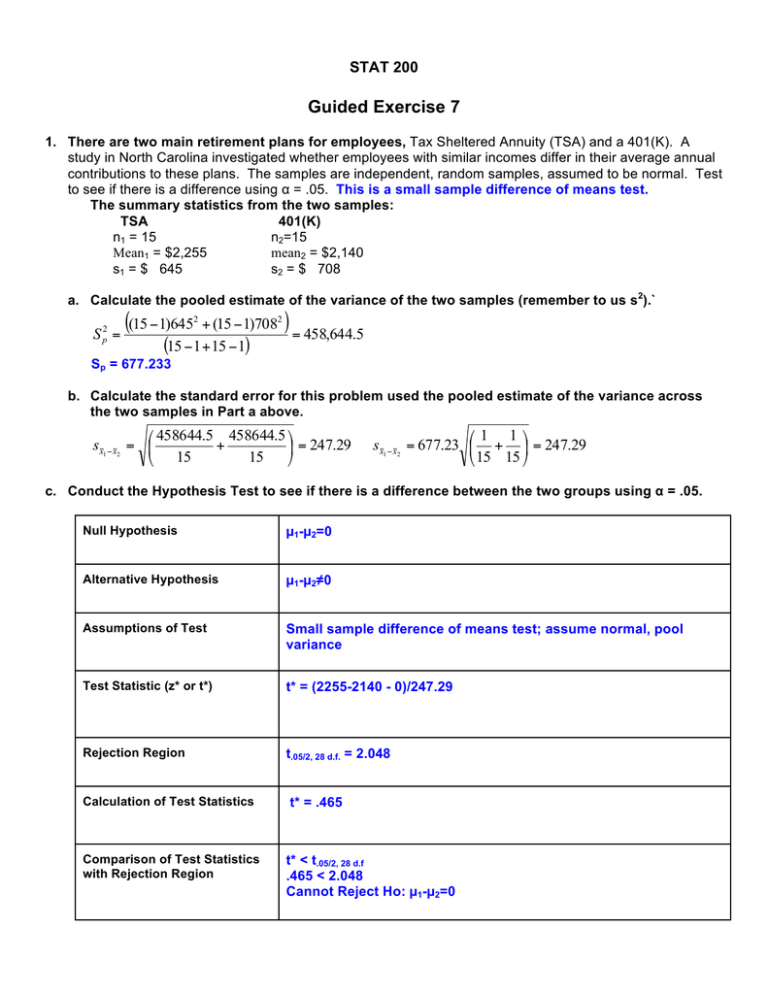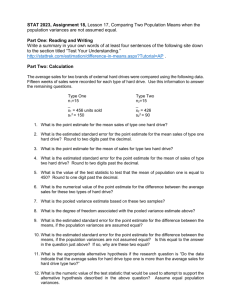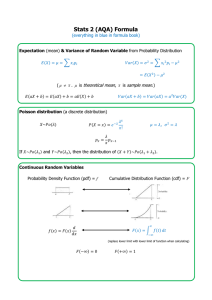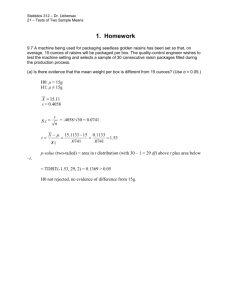Guided Exercise 7 STAT 200
advertisement

STAT 200 Guided Exercise 7 1. There are two main retirement plans for employees, Tax Sheltered Annuity (TSA) and a 401(K). A study in North Carolina investigated whether employees with similar incomes differ in their average annual contributions to these plans. The samples are independent, random samples, assumed to be normal. Test to see if there is a difference using α = .05. This is a small sample difference of means test. The summary statistics from the two samples: TSA 401(K) n1 = 15 n2=15 Mean1 = $2,255 mean2 = $2,140 s1 = $ 645 s2 = $ 708 a. Calculate the pooled estimate of the variance of the two samples (remember to us s2).` S p2 = ((15 −1)645 2 ) + (15 − 1)7082 = 458,644.5 (15 − 1 + 15 − 1) Sp = 677.233 b. Calculate the standard error for this problem used the pooled estimate of the variance across the two samples in Part a above. ⎛ 458644.5 458644.5 ⎞ sx1 −x2 = ⎜ + ⎟ = 247.29 15 ⎝ 15 ⎠ ⎛ 1 1 ⎞ sx1 −x2 = 677.23 ⎜ + ⎟ = 247.29 ⎝ 15 15 ⎠ c. Conduct the Hypothesis Test to see if there is a difference between the two groups using α = .05. Null Hypothesis µ1-µ2=0 Alternative Hypothesis µ1-µ2≠0 Assumptions of Test Small sample difference of means test; assume normal, pool variance Test Statistic (z* or t*) t* = (2255-2140 - 0)/247.29 Rejection Region t.05/2, 28 d.f. = 2.048 Calculation of Test Statistics Comparison of Test Statistics with Rejection Region t* = .465 t* < t.05/2, 28 d.f .465 < 2.048 Cannot Reject Ho: µ1-µ2=0 d. Confirm that if the sample sizes are equal for each group, the pooled variance is simply the average of the two variances. (416,025+501,264)/2 = 458,644.5 When the two sample sizes are equal, the pooled variance formula simplifies to an average of the variances. 2. Geneticists have identified E2F1 transcription factor as an important component of cell proliferation control. The researchers induced DNA synthesis in two batches of serum-starved cells. In one group of 92 cells (treatment), cells were micro-injected with the E2F1 gene. A control group of 158 cells was not exposed to E2F1. After 30 hours, researchers determined the number of altered growth cells in each batch. Test to see if the proportion of growth altered cells for the treatment group is larger than that of the control. Conduct the hypothesis test using Use α = .01. Note: this is a difference of proportions test. For a difference in proportions test where the null hypothesis says the two groups are equal, we should make a pooled estimate of the proportion (using information from both groups) to estimate the standard error of our test. Control E2F1 Treated Pooled estimate Total cells 158 92 250 Number of growth altered cells 15 41 56 p for each group a. .0949 .4457 .2240 The pooled estimate of p for this problem is (denoted as pp) and the pooled estimate of q (denoted as qp) : pp = b. (15 + 41) = 56 = .2240 (158 + 92) 250 The standard error for this test is (note the formula to the right): σ ( p1 − p2 ) = &1 1# p p q p $$ + !! % n1 n2 " ⎛ 1 1 ⎞ 1 ⎞ ⎛ 1 + ⎟⎟ = .2240 * .7760⎜ + ⎟ = .0547 ⎝ 158 92 ⎠ ⎝ n1 n2 ⎠ σ ( p − p ) = p p q p ⎜⎜ 1 c. 2 Conduct the Hypothesis Test to see if the proportion of growth altered cells for the treatment group is larger than that of the control. Conduct the hypothesis test using Use α= .01. Null Hypothesis Pt - Pc = 0 Alternative Hypothesis Pt - Pc > 0 one-tailed test Assumptions of Test Large sample difference of proportions test; assume normal, pool variance Test Statistic (z* or t*) z* = (.4457-.0949 - 0)/.0547 Rejection Region z.01 = 2.33 Calculation of Test Statistic z* = 6.42 Comparison of Test Statistics with Rejection Region z* > z.01 6.42 > 2.33 Reject Ho: Pt - Pc = 0 d. What is the p-value for the test statistic? A z* = 6.42 is very large. We can’t even look it up in the standard normal table So just say, p < .001 This is very small and good enough for most people reading your research By the way, the real p is .0000000001! Females Males About Right 87 64 151 Overweight 39 3 42 3 26 29 Underweight Column Totals 129 93 Row Total 222 3. The following is some data from a survey of 222 college students. The data show the breakdown of responses to how they feel about their weight by their gender. The responses to how they perceived their own weight were, “about right,” “overweight,” and “underweight.” The data are given to the right. We can assume that their feelings about their weight is the “dependent” variable. a. We will focus on the Female vs Male response to “About Right.” I want you to conduct a difference of proportion test to determine if Females and Males had different perceptions about their weight being “About Right.” Use alpha = .05. Remember to calculate the pooled proportion for this problem first, before calculating the standard error. Use alpha = .05 ⎛ 1 1 ⎞ 1 ⎞ ⎛ 1 + ⎟⎟ = .6802 * .3198⎜ + ⎟ = .0634 ⎝ 93 129 ⎠ ⎝ n1 n2 ⎠ σ ( p − p ) = p p q p ⎜⎜ 1 2 pp = (87 + 64)/(129+93) = (151)/222 = .6802 HYPOTHESIS TEST Null Hypothesis Pm - Pf = 0 Alternative Hypothesis Pm - Pf ≠ 0 two-tailed test Assumptions of Test Large sample difference of proportions test; assume normal, pool variance Test Statistic (z* or t*) z* = (.6882-.6744 - 0)/.0634 Rejection Region z.05. = 1.96 Calculation of Test Statistic z* = .2177 Comparison of Test Statistics with Rejection Region z* < z.05 .2177 < 1.96 Cannot reject Ho: Pm - Pf = 0 What is the p-value of your test? The p-value? Look up .22 in standard normal table. .0871 Subtract from .5 .5-.0871 = .4129 Multiply by 2 for two-tailed test .8258 4. This problem looks at the salary differences of Male and Female Mid-Level Managers at 220 firms. We will be looking at an Excel file with data on mid-level managers in 220 firms. The salary is given in $1,000s. We want to look at the female sample (n=75) and compare it to the male mean level (144) to see if it is lower than that of males (or if males is higher). Use an alpha level of .01. Here are the Excel output: a. Summarize the salary levels for men and women at the company using the descriptive statistics. Male salary slightly larger – $144K compared to $140k for females. Mean and median very close for both groups. Variances are very similar for both groups Spread is not too large for either group – they are all managers approximately 8.8% C.V. Here is the JMP output for a t-test assuming unequal variances. Use it to conduct the test below using an alpha level of .01. c. Conduct the Hypothesis Test to see if women earn less than men using α = .01. Null Hypothesis µm-µf=0 Alternative Hypothesis µm-µf≠0 Assumptions of Test Large sample difference of means test; assume normal, pool variance Test Statistic (z* or t*) t* = 2.056 Critical Value at the Rejection Region t = 2.352 Comparison of Test Statistics with Rejection Region The test statistics is 2.056 it is less that the critical value at the rejection region. We cannot reject Ho: No difference d. What is the p-value for this test? All we need do is read the value from the JMP output. Given this is a two-tailed test we use Prob > |t| = .0415 e. How would you explain your test result in words. We observed a difference between of the male and female salary of $3,644. When we tested that difference it was not statistically significant at the .01 level for a two-tailed test. This at this level of certainty we cannot be sure if there is a real difference. However, our test would have been significant it the error rate was .05, since the p-value for a two-tailed test was .0415. f. Could we have assumed the variances of the two groups were equal? Brainstorm a bit to decide how we might do this? The easiest way to do this is to divide the two variances and see if the result is close to one. In a formal test, this is called an F-test and it follows an F-distribution. When creating this ratio it is best to put the larger variance first, so we will look at the rtion of females to males. For our purposes the ratio is: 156.144/153.613 = 1.016 These variances are very close to one another and it would have been reasonable to assume the variances were equal. In terms of our test, this would have changed the standard error a small bit, and the degrees of freedom would have increased from 148.687 to (145-1) + (75-1) = 218. However, using a pooled variance would not have changed the result of the test at alpha = .01 level. g. I am including the output assuming equal variances from JMP. Did it change the results of the test much? Very little difference whether we assume or not assume equal variances – the sample sizes are LARGE 4. Earlier we look at some summary data from each state and the District of Columbia for a 20 question test on driving. The score of the test was calculated as 5 points for each correct question. I administered the same test to 65 graduate and undergraduate students in statistic classes in summer 2010. I am going to give you the summary information on the scores for all 65 students as well as a breakdown of the scores for graduate students and undergraduate students from JMP. I want you to do the following: a. Describe the distribution of the test for all 65 students. b. Conduct a two-tailed difference of means test between undergraduate and graduate students. The results are given in JMP. All you need to do is summarize the results. H0: µundergrad – µgrad = 0 Ha: µundergrad – µgrad NE 0 two-tailed test Assume equal variances. The test statistic from JMP is -1.960 The p-value for a two-tailed test for this value is .0545. This result would not meet the criteria for a two-tailed test with alpha equal to .05. It would meet the criteria is we were able to accdept a larger Type I error, for example at alpha equal to .10. Based on an alpha level of .05, we would fail to reject the Null Hypothesis and conclude we do not have enough evidence to say the scores of undergrads and graduate students are different. c. Would the results have mattered if we used a one-tailed test that graduate students would score better than undergraduate students? If we used a one-tailed test the p-value is .0272 that undergraduate students are lower than graduate students (this means the same thing as graduate students score better). Note the JMP software conducted the test as Undergraduate – Graduate. Based on this result, we would have been able to reject at alpha equal to .05.





